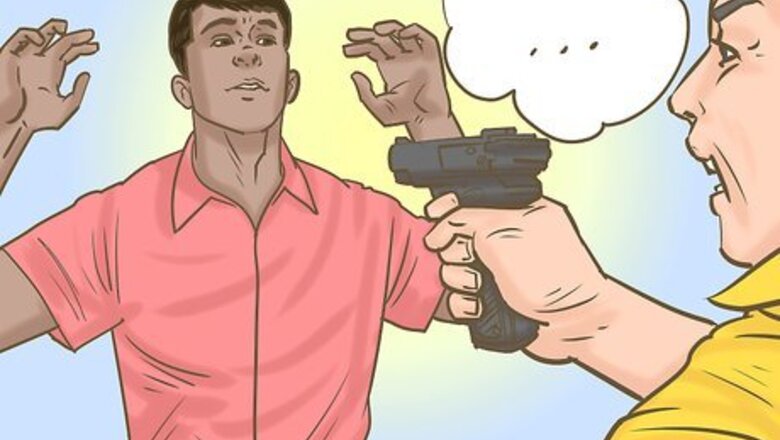
views
Complying with a Robber
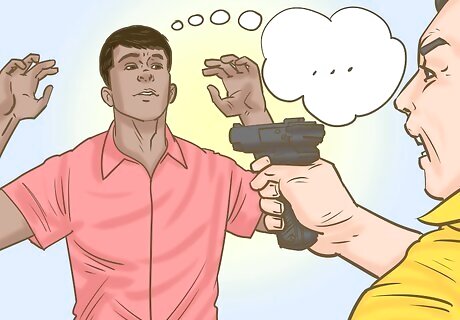
Try to stay as calm as you can. If a robber is pointing a gun at you, don’t shout at them, scream, or make sudden movements. Take deep, slow breaths, and avoid thinking panicked thoughts. Pay attention to the robber’s commands, but try to think reassuring phrases to yourself. Focus on controlling your breathing, and think to yourself, “Everything will be okay. Staying calm will help me get through this.” Remaining calm can help you think clearly. If you're calm, you might also be more likely to remember details when you report the situation to the police. Additionally, panicking or making sudden movements will make the robber more unpredictable.
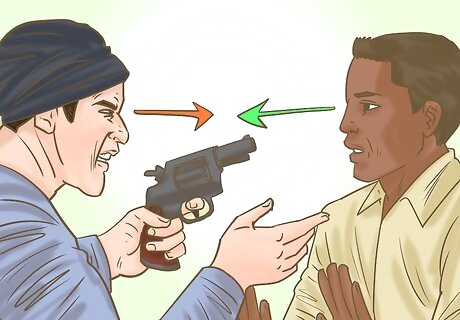
Make eye contact with the robber to humanize yourself. If possible, mention your family, children, a hobby, or other personal characteristics. Comply if they command you to look away or stop talking, but do your best to get them to acknowledge you as a human being. Try saying, “I have 2 daughters and a spouse, and I need to get home to them tonight. Please, just take what you want and don't hurt me.” Reminding them that you’re a person with a life to live can make it more difficult for them to fire their weapon at you. When you look at them, look for a birthmark, tattoo, scar, or another unique feature. Try not to make it obvious that you’re studying their features, or they might feel threatened and become aggressive. If they command you to look away, comply.
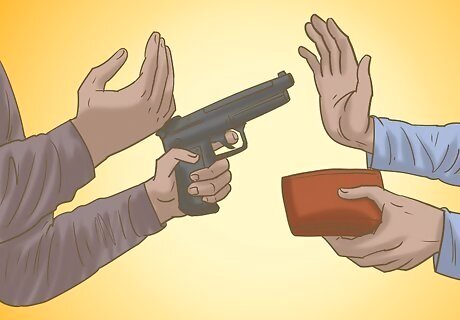
Give them what they ask for instead of fighting back. Defend your life, not your possessions. Your money, watch, and phone are replaceable. Even if an object holds sentimental value, it’s not worth risking your life. If you have to put your hand into your pocket, announce your movements and reach for your valuables slowly. Put your hands up with your palms facing out, and say, “Okay, I’ll do what you say. I’m going to reach for my wallet.” Give the robber what they ask for, but don’t volunteer anything more. If they ask for your purse or wallet, give it to them. Unless they tell you to empty your pockets or search you, don’t tell them about other valuables in your possession.
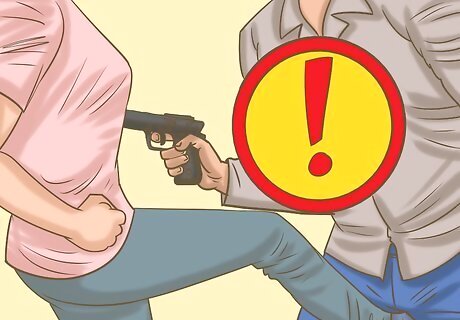
Fight for your life only if it's absolutely necessary. If you are carrying a firearm, quickly use it. Most people who are held at gunpoint are robbery victims. In these cases, the robber wants your belongings and will most likely flee once you’ve cooperated. However, do not comply if an assailant attempts to kidnap you, forces you into a car, or fires their weapon at you. Try looking past their shoulder and nodding, or say “There you are! Help!” Or “Finally!” as if there were someone behind them. When they turn to look, mount a defense or run away toward a safe location. If possible, run in a zigzag pattern so you’re a more difficult target. If you need to defend yourself, look for nearby objects to use as improvised weapons. Attempt to disarm the attacker and target their eyes, neck, and other sensitive areas. If you’re held at gunpoint, do not attempt to fight or flee unless it’s clear your life is imminent danger. If you’re being mugged, comply. If an assailant is attempting to force you into a car or shoots at you, do everything in your power to run away or defend yourself.
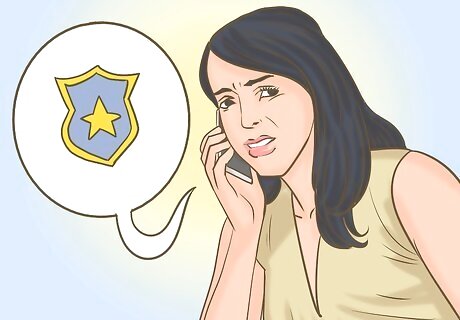
Call emergency services when you can safely do so. Once the robber has left, get to a well-lit, populated area as quickly as possible. When you’re in a safe location, call the police and wait for responding officers. If you were robbed at home or in a store and stay on scene, don’t touch anything. Do your best to note any surfaces the robber touched, especially if they weren’t wearing gloves. Report these spots to the police so they can check for fingerprints. If possible, try to see which way the robber fled. If they left in a vehicle, do your best to note the make, model, year, color, license plate number and issuing state, and any other distinguishing features.
Responding to an Active Shooter
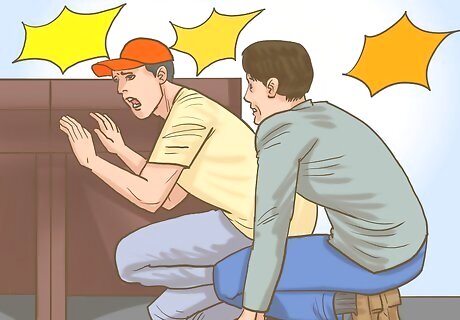
Duck and cover if you hear nearby gunfire. Stay calm, get to the ground, and cover your head the moment you hear shots fired. Don’t flee immediately, as you won’t know the origin of the shots or whether there’s crossfire. Once you’ve determined where the gunfire has come from, run away in the opposite direction. If you’re within the shooter’s range, try to run in a zigzag pattern so they’ll have a harder time targeting you. When a robber points a gun at someone, the aim is to get that person to surrender money or valuables. In these situations, it’s important to comply. In an active shooter situation, the assailant’s intent is to harm, so fleeing and hiding are the best responses.
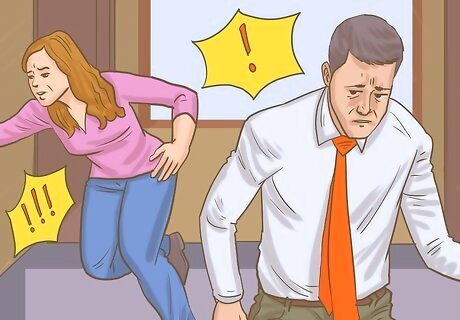
Run to a safe area, if possible. If you’re in an active shooter situation in a public place, run away from the shooter and head for the nearest exit. Leave your belongings behind and evacuate as quickly as possible. If there are responding police officers in the vicinity, remember that they probably don’t know who the shooter is. Don’t be afraid of them, but make sure your hands are visible and follow any instructions they provide. Run as far away from the building as possible. Don’t stop outside the door or in the parking lot. Run to your school or business’s designated secure location, to the place police instruct you to go, or until you’re certain you’re out of danger.

Hide in a secure spot if evacuating isn’t possible. If there’s no available exit, look for a room that locks from the inside or can be barricaded. Lock the door, turn off the lights, close the blinds, and block the door with heavy furniture. If you can’t get to a locked or barricaded room, try to find a spot where you’ll be out of sight. Silence your cell phone; do not leave it on vibrate. Don't respond to any knocks on the door, even if the person says they’re a police officer. Remain absolutely quiet. If it's actually responding officers at the door, they’ll likely break through to clear the area. Officers typically respond in groups of 4; they may have standard uniforms or wear tactical gear. Remember to put your hands up and follow their instructions so they know you’re not the shooter.
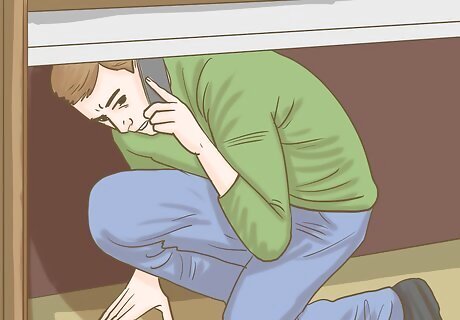
Call emergency services only once you’re away from the shooter. To avoid drawing attention to yourself, do not call emergency services in the presence of the shooter. Once you’ve evacuated to a secure location, call the authorities immediately. If you’re hiding, don’t talk on the phone unless you’re certain the shooter isn’t nearby. Stay as quiet as you can if there's any chance they're within earshot. If possible, send a text or use social media to alert others of the situation.
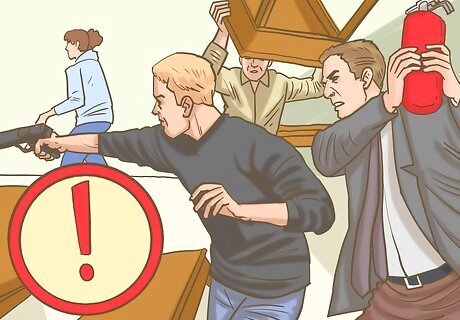
Fight back only as a last resort. If you cannot run or hide, throw objects at the shooter and shout aggressively. Look for objects that can be used as improvised weapons, such as a fire extinguisher, a chair, a potted plant, or scissors. If there are other people nearby, try to recruit them ambush the shooter. It’s important to commit to your actions. Not everyone is comfortable with causing severe or fatal injury, and it’s okay if you aren’t. But if you’re going to engage the shooter, you need to be committed to disabling them by any means necessary. Remember that running and hiding are the best options. Fight for your life only if there are no other alternatives.
Avoiding Dangerous Situations

Walk in groups, especially in dark or unsafe areas. Avoid walking alone at night, especially in unfamiliar places, and try to stay on busy streets. Whether it’s day or night, crowded, well-lit streets are generally safer than dark, abandoned alleys. If you’re alone on an empty street and a stranger tries to talk to you, keep walking. Don’t answer if they ask for the time or for bus fare. Get to a well-lit public area; if they follow you or act in a threatening manner, call emergency services. If you’re traveling, look online or ask the hotel desk about safe and unsafe parts of the city.
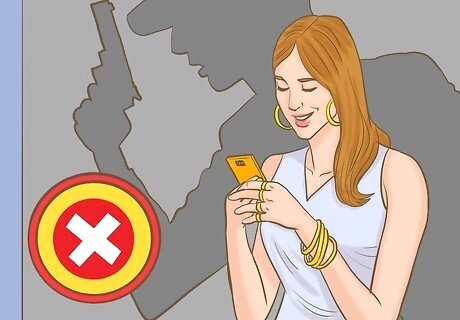
Avoid flaunting expensive valuables and cash. Try to blend in and don’t call attention to your jewelry, cash, or other valuables. Waving around handfuls of cash or boasting about your possessions may attract unwanted attention. A robber weighs the risks and benefits when they choose their target. Someone who blends in or seems run of the mill might not justify the risk of getting caught. On the other hand, in a robber’s mind, someone who seems like they’re flush with cash would be worth the risk. In addition to being discreet with your cash, try to carry as little on you as possible. Instead, use a debit or credit card, which you can promptly deactivate if it’s stolen. You should also avoid withdrawing money from an ATM by yourself at night.

Walk purposely with your chin up and shoulders back. Robbers and predators look for people who might be lost, not paying attention, or timid in appearance. Try to appear confident and look like you know where you’re going. Walk with medium strides with your head held high, and swing your arms naturally as you walk. To predators, people who walk with small strides and hold their arms still by their sides appear to be slower, more timid, and easier targets. Keep your head on a swivel as well, and glance at passersby. Don't stare at your phone or a map while you walk. Remaining alert and aware of your surroundings makes you appear to be a more difficult target.
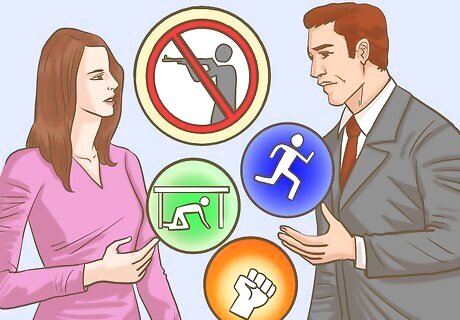
Learn your school or employer's active shooter protocols. Your school or place of work likely practices active shooter drills or has an emergency evacuation plan. Familiarize yourself with emergency exits, designated assembly areas, rooms that lock from the inside, and other aspects of the emergency plan. If you're not sure whether your school or employer has active shooter protocols, talk to your teacher or supervisor.
















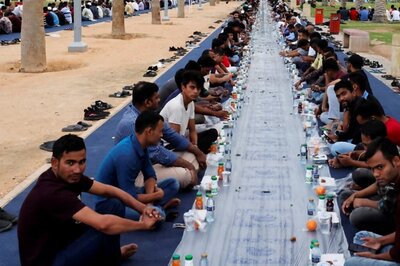


Comments
0 comment